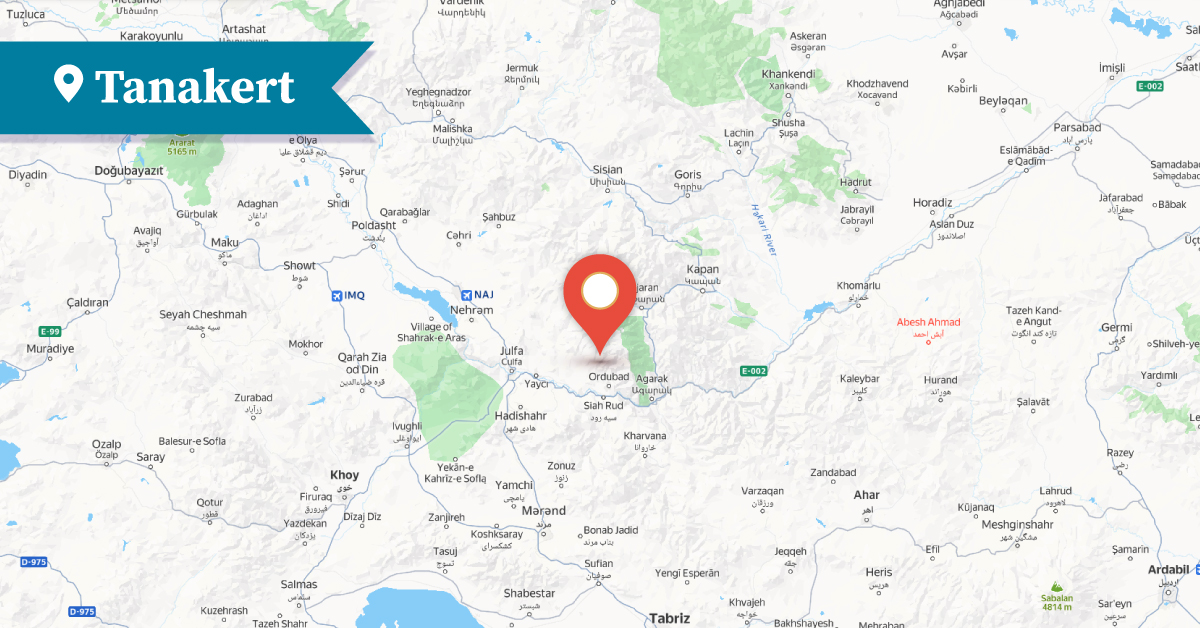2025
2025
2025-08-14

Tanakert was one of the notable Armenian villages of the Goghtn district (Goghtan) in the Vaspurakan province of Greater Armenia. It was located 6–7 km northwest of the town of Ordubad in Nakhijevan. It was also known by the names Danagird, Danakert, Tnakert, and Tonakert. [1]
A number of references about the village have been preserved. For example:
“The village of Tanakert of the Armenians, with 60 and more houses. In the register of the monasteries of Galatia, the name of this village is written as Tonakert, which seems to be the correct form, mentioning some local native donors, Arakel, son of Hovhannes, in the middle of the 17th century.” [2]
“Three versts below Tronis[3] is the village of Tanakert, situated on the slope of a hill of the same name, on the right bank of a small river.” [4]
The village houses were modest, with gardens in front, which “gave the village a rather beautiful appearance,” and only “one of the streets was regular and tree-lined, the others winding and crooked.” Tanakert’s climate was relatively warm, and the dales had “vineyards.”[5]
The village has been mentioned as a settlement since ancient times. Archaeological finds from the surrounding area include Bronze Age artifacts and rich pottery.
In 1831, the village had 177 Armenian inhabitants, and in 1873—457. According to 1904 statistical data, Tanakert had 66 houses and 527 Armenian inhabitants, while in 1906—774. In 1914, the village was entirely Armenian-populated.
The inhabitants were Zoks and spoke the Zok dialect. About the Zoks, E. Lalayan noted that they were natives and “not numerous, inhabiting only Upper and Lower Agulis, Andamej, Disar, Tsghna, Tanakert, Ramis, Kaghakik, and P’araka.” [6]
The villagers were mainly engaged in gardening, fruit-growing, sericulture, and animal husbandry.
In 1873, an Armenian (parish) three-year coeducational school was opened in the village, operating intermittently until 1917.
A 1907 document titled “Colophon of Tanakert Village” printed in Tiflis has been preserved. It contains the school’s charter consisting of ten rules. It presents regulations for pupils’ moral conduct, class schedules, a list of subjects, rules for attendance and absences, discipline, attending church on Sundays and feast days under a supervisor’s guidance, as well as the duties of pupils, parents, and guardians. [7]
In the northeastern part of the village stood the Church of the Holy Mother of God. The date of its construction is unknown. It was a four-pillar domed basilica. Traces of mural painting were preserved on its walls—19th-century frescos, whose fragments eventually deteriorated. The church was renovated in the 17th and 19th centuries. It was also a notable manuscript-copying center, from which two manuscripts dated 1710 and 1719 have reached us.
The church preserved a parchment Gospel written in 1456 “in the Monastery of St. Mamas by the hand of the priest Matheos.”[8] Besides the Gospel, other manuscripts were kept there: three copies of the Haysmavurk (Synaxarion), three Gospels (only one with a colophon, copied in Kars in 1671), one Mashtots, and a Khorhrdatetr (missal) written in 1685.
On the western side of the Holy Mother of God Church, a narthex–chapel was built in the 17th–18th centuries. No inscriptions, reliefs, or decorative carvings have survived on the church’s walls.
On the 1977 Soviet topographic map, the Holy Mother of God Church of Tanakert was marked. It was still standing in the 1980s–1990s. However, it was destroyed between 1997 and 2000, and its traces were completely erased by 2009.
About 1–1.5 km south of Tanakert, in a place called Berdak, stood the pilgrimage site of Surb Hovhannes Church, dating to the 16th–17th centuries, with one stone in its wall dated 1524. The site was renovated in 1888. In the early 1990s, the church was semi-ruined, and later completely destroyed.
There were no Islamic monuments in the village.
In 1914, the painter Martiros Saryan traveled in Goghtn and created an unmatched series of landscapes of Armenian settlements in the region, including the painting “Goghtn (Tanakert).”
Like the other Armenian villages of Southern Goghtn, Tanakert was attacked in the summer of 1919 by Turkish–Tatar bands. The village’s self-defense lasted for ten days, after which the enemy captured Tanakert and massacred most of its inhabitants.
During the Soviet period, a small number of Armenians lived in the village, who finally abandoned their homes in 1988–1989.
Like the other Armenian villages of Goghtn, Tanakert is now inhabited by Azerbaijanis, located in the Ordubad district of the Nakhijevan Autonomous Republic, and is called Anaqut.
Bibliography
Ghevond Alishan, Sisakan, Venice, 1893.
Yervand Lalayan, Nakhijevan Province, Book XI, 1904.
A. Yeprikyan, “The Self-Defense of Goghtn in 1919,” Ejmiatsin, no. 5, 2012․
A. Ayvazyan, The Armenian Monuments of the Nakhijevan ASSR: A Comprehensive List, Yerevan, 1986.
Nakhijevan Atlas, Research on Armenian Architecture Foundation, Yerevan, 2012.
T. Kh. Hakobyan, St. T. Melik-Bakhshyan, H. Kh. Barseghyan, Dictionary of Toponyms of Armenia and Adjacent Regions, Vol. 5, Yerevan, 2001.
Colophon of Tanakert Village, Tiflis, 1907.
Caucasus Heritage Watch, https://storymaps.arcgis.com/stories/90488005393f4f9aa2bf210bac0e3854
[1] T. Kh. Hakobyan, St. T. Melik-Bakhshyan, H. Kh. Barseghyan, Dictionary of Toponyms of Armenia and Adjacent Regions, Vol. 5, Yerevan, 2001, p. 28.
[2] Ghevond Alishan, Sisakan, Venice, 1893, p. 341.
[3] Village in the Goghtn district of Nakhichevan
[4] Yervand Lalayan, Nakhijevan Province, Book XI, 1904, p. 316։
[5] Ibid.
[6] Ibid. pp. 205-206։
[7] Colophon of Tanakert Village, Tiflis, 1907.
[8] Yervand Lalayan, Nakhijevan Province, Book XI, 1904, pp. 172-173